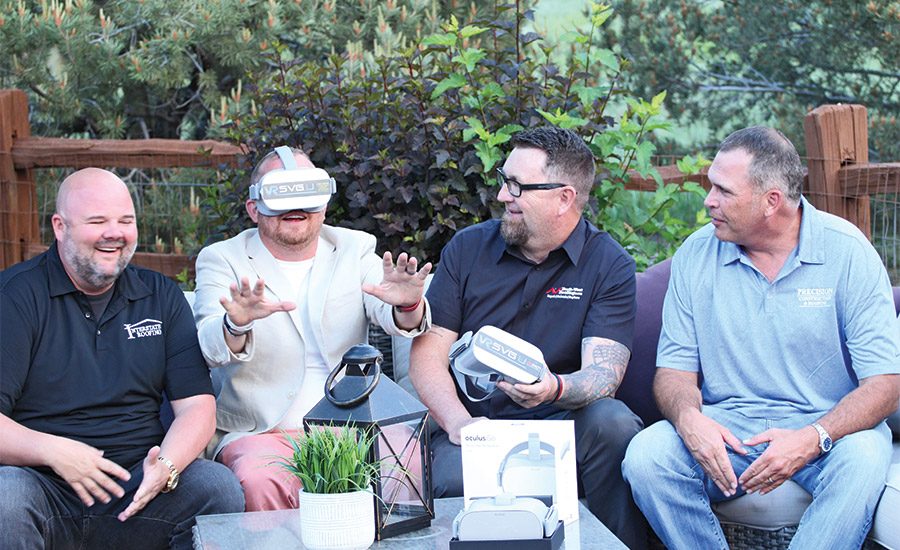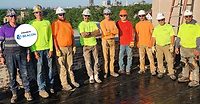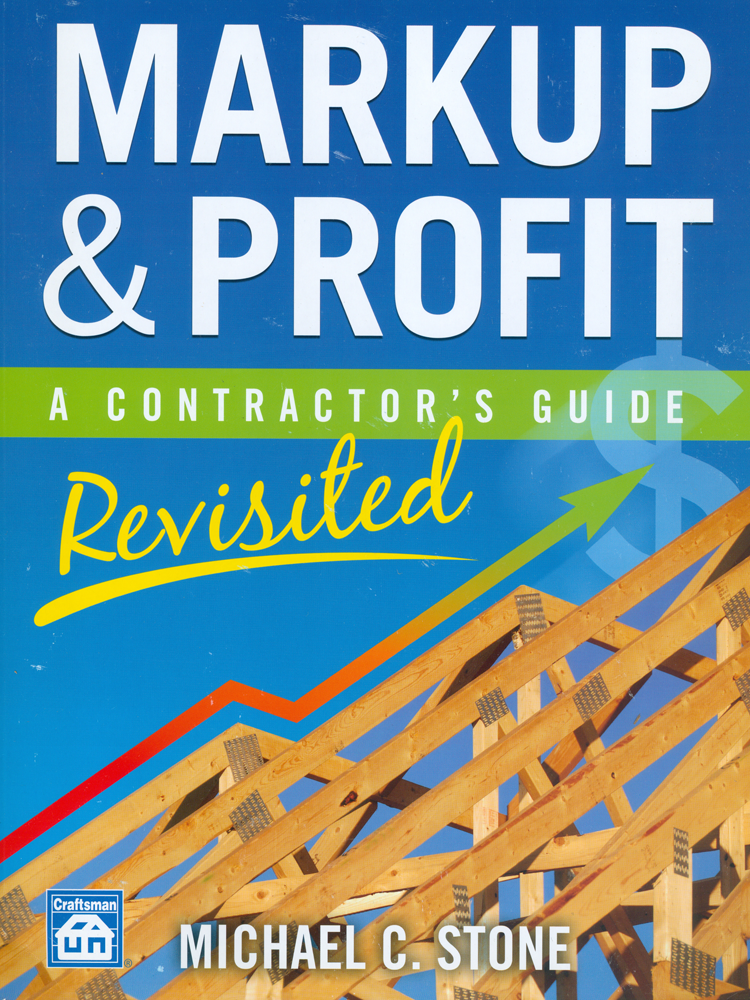Top 100 Roofing Contractors from Across Storm Country are Using VR and Other Technology to Reach New Heights

“This technology is a great resource to our contractors as they can learn, visualize, and improve on their own,” said Interstate Roofing Owner Scott Riopelle (far right). “It’s proven to me that expressing the importance of this technology has provided the contractor teams with another tool to make them successful and safe.” Pictured also (from left:) Steve Soule, CMR Roofing; Sam Struthers, Crest Exteriors; Anthony Delmedico, Storm Ventures Group; Eric Hunter, Precision Construction and Roofing; and Paul Reed, North West Roofing. Photos by Trisha Eileen Buck.

“We use VR and online training to get new recruits in the field sooner. Saving time from our trainers and more experienced reps allowing them to produce more,” said Sam Struthers, president, Crest Exteriors , of Plano, Texas (below, wearing goggles.)


The introduction of VR and AR technology into the roofing contractor space may not have immediately generated the same amount of excitement and widespread acceptance as when milestone products like EPDM and aerial imagery first appeared.
But roofing contractors are beginning to see the potential for improved training and maximized sales opportunities by incorporating more and more of the technology into their everyday business models. Already lost? No problem. A quick primer: VR, or virtual reality, is the use of computer-generated imagery to build an all-encompassing, simulated environment for the user. Augmented reality, or AR, builds on that simulated environment and creates a more interactive experience by blending in real-world elements.
Both have practical applications for businesses in several fields that are just beginning to evolve. It was only just about five years ago that futurists were the only ones raving about VR technology’s potential implications for commerce. Now, visionary entrepreneurs and established business owners alike are beginning to realize benefits to key parts of their operations. What’s already proven to be an irreplaceable asset in
the medical, communication and logistics fields, is now moving into
the construction world — and roofing
in particular.
Changing the Game
Anthony Delmedico believes it’s no coincide or surprise that the industry is gravitating toward these tools, in particular, as multitudes of different technology floods into the roofing space. The former roofing contractor-turned consultant and entrepreneurial trainer actually sees them as essential for any roofing company looking to overcome the workforce challenges plaguing the industry.
“Recruiting, onboarding and training are some of the toughest issues facing roofing contractors today. This technology helps attract, train, and retain talent in the new millennia,” the CEO and Founder of Storm Ventures Group (SVG) said.
In addition to managing ongoing training programs and planning the annual Win the Storm event, Delmedico’s newest innovation is SVG-U 3.0, a customized training platform that covers key areas of roofing jobs from instructions on in-the-field installations, to simulated sales scenarios with real-time factors. “We make selling roofs a fun and lucrative opportunity inside this state of the art technology,” Delmedico said.
Admittedly leery of the cost and uncertain functionality of new technology, Paul Reed, general manager of North-West Roofing in Denver, said it took a while to warm up to the idea of using VR goggles, drones and wearable devices to enhance a roofing job. But he’s glad he did.
“Up until five years ago, I was unwilling to look outside our own company for new ideas. Once I did we have literally tripled our business,” Reed explained. “Drones have been a game changer for multi-family and HOA inspections, and VR has simplified our sales training process.”
Overcoming that initial fear was difficult, but was really a pragmatic way to simplify processes while harnessing the power of their own data through lead tracking, he said.
Sam Struthers, owner and CEO of Crest Exteriors, LLC, in Plano, Texas, shared that initial apprehension.
“Of course we were (skeptical),” Struthers said of incorporating VR into their sales process. “The technology is new and changing policy inside the company is not something we take lightly. We did our due diligence and decided that it was the right time to change the way we train. We saw the efficiencies it would add and were willing to take the leap. The team has loved it.”
Train to Retain
With staffing reliable, efficient roofing crews at a premium, employee retention is the best avenue to keep company processes and workflow consistent. The company CEOs that have implemented VR training contend that consistency leads to profitability. And they’ve found that relying on technology can help them stay more productive and thus feel more successful.
At CMR Construction and Roofing the training expands from the rooftop to the office, where the sales team has already shown positive gains, said CEO Steve Soule.
“Related to our sales force, the more effectively we can train, the faster our trainees can achieve success,” he said. “Success enables retention.”
Interstate Roofing’s Scott Riopelle said additional sales, profits and bonuses aren’t the only draws to retain top people. The education piece tied to the technology is also keeping people in the business longer and creating more company loyalty through opportunities.
“This technology speaks to the new generation of contracting salespersons,” he said. “It has increased our retention base by allowing multiple avenues of education, while providing another way to evaluate the skills of a contractor before we finalize a contractor agreement or put them in the field blindly. What this caused is a more loyal base of employee and contractor alike.”
When roofing crews travel to meet the demand of unexpected storms, the technology also comes in handy for accountability purposes, notes Eric Hunter, owner of Precision Construction and Roofing in North Richland Hills, Texas.
“We have guys in 11 states. I don’t have the time to look over their shoulders and make sure they are doing what they are supposed to,” Hunter said. “Guys that were struggling now go out and have a much easier time.
“I have 4 guys that have weekly turned in $1.2 million since March. That’s collected not sold. That’s pretty
damn good.”
Just the Surface
While new tools and training techniques are keeping their teams plenty busy, these Top 100 roofing contractors know technology will only continue to improve, and that new product innovations or enhancements are on the way.
They agreed that the best ones will be focused on improving rooftop efficiency while also incorporating safety.
“Safety is the biggest motivator for me and the use of technology,” Riopelle said. “This industry can be dangerous, and I welcome any technology that will help keep my staff and contractors safe.
“VR technology is one of those leaders that is helping to train in a safe environment while providing a valuable tool. Second to safety is the ease of use, streamlining processes, data on demand; all of which helps us to educate our homeowners and provide exceptional customer service and products.”
Trying to quantify a return on investment, particularly when some of the more common tech. tools can be pricy, is hard to do.
“A simple indicator is evaluating how the company runs overall,” Soule said. “You can tell when things are running more smoothly and efficiently. You can also tell when the technology is causing more burden than it’s relieving.”
Looking for a reprint of this article?
From high-res PDFs to custom plaques, order your copy today!











